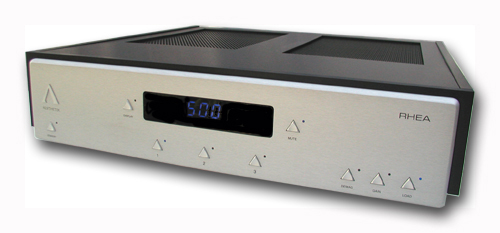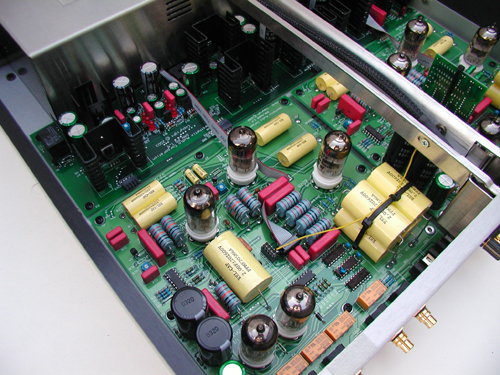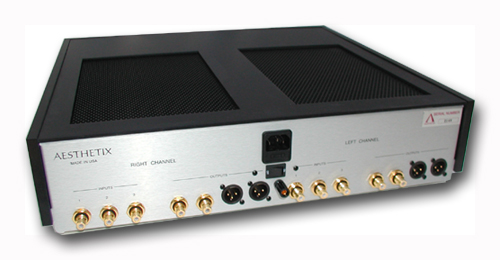You are reading the older HTML site
Positive Feedback ISSUE
13
may/june 2004
aesthetix
Rhea phono stage
as reviewed by Robert H. Levi and Dave Clark

Photographs and image processing by Dave Clark
ROBERT H. LEVI'S SYSTEM LOUDSPEAKERS ELECTRONICS SOURCES CABLES
ACCESSORIES
|
 Be
careful what you wish for—you just might get it! In a recent review of the
outstanding Cary 302 phono stage, I said that it was an exceptional value,
but that I would pay more for added flexibility. Enter the Aesthetix Rhea,
with superb sound and all the control an obsessed audiophile could ever
want. It costs about $1600 more, but you can tweak everything, and
get a remote as well. What a joy! I was well entertained by this ten-tubed
wonder, and you will be too.
Be
careful what you wish for—you just might get it! In a recent review of the
outstanding Cary 302 phono stage, I said that it was an exceptional value,
but that I would pay more for added flexibility. Enter the Aesthetix Rhea,
with superb sound and all the control an obsessed audiophile could ever
want. It costs about $1600 more, but you can tweak everything, and
get a remote as well. What a joy! I was well entertained by this ten-tubed
wonder, and you will be too.
I'd better mention this first, since this was the Rhea's only significant problem, although it may have been unique to the review sample. In single-ended operation, the Rhea performed flawlessly. It was dead quiet, even with Kimber Select cables, which are not shielded. Whether it was plugged into the same circuit as the preamp or not, ground floating or not, the Rhea was silent. In balanced operation, however, the review sample was noisy. Balanced operation usually means twice the gain and half the noise, but there was a tube roar that I could not eliminate or reduce below audibility. I tried everything including a rain dance to fix it, without success. I even hooked it up directly to my E.A.R. 890 amplifier, which has volume controls. The noise only became clearer. The unit sounded okay above the noise floor, but I decided to focus exclusively on the unit driven single-ended. It may simply have been a noisy tube, but I had no way of checking.
The Rhea is the most flexible phono stage I have encountered in forty years of hi-fi fun. It even has a built-in, and most useful, cartridge demagnetizer! The Rhea has RCA inputs for three tonearms, multiple RCA and XLR outputs, a detachable power cord, and front controls for gain and load, with memory for each input, mute, demag, and standby. It even has a remote that you can use to access all of the above from your easy chair. This is an audiophile toy of the highest order, and a real 21st Century design. All the tubes are easily available Sovtek 12AX7s and 6DJ8s. All of the switches and controls worked flawlessly. This is a well thought out and well built unit. Did I mention the remote? Interestingly, after setting the load and output, the only controls I used often were the mute and demag buttons. I thought I'd go wild with the features, but with only one cartridge, I didn't.
The Rhea was hooked to my Benz Ruby2H cartridge (.7mV output) via Kimber TAK Phono AG cables. I used a Tara Decade Power Cord on the Rhea, plugged into the same circuit as the preamp and fully grounded. I used Kimber Select single-ended cable to connect the Rhea to my PassX1 preamp. The system is balanced from there to the E.A.R. 890 amp with Kimber Select Silver interconnects and speaker cables. The speakers are Avalon Eidolons plus a Rel Stadium III subwoofer crossed over at 24 Hz. My reference phono stage is the E.A.R. 324. The Rhea was run for more than 150 hours before reviewing. Though it has a standby mode that keeps the tubes slightly warm, it needs to be on for at least an hour to reach peak sound, and actually sounds best with two hours of warm-up. The Rhea was isolated from anything digital and was far away from the amplifier. By the way, do not play the unit with the top off—it hums. It is ultra easy to remove to change tubes, as it's Velcroed to the chassis!
I listened to the following LPs:
-
Getz/Gilberto (Mobile Fidelity 1-208)
-
Best of Count Basie (Verve V68596)
-
The King James Version (Sheffield Lab-3)
-
Star of Wonder (Reference Recording RR-21)
-
Duke Ellington, Blues in Orbit (Classic Records 8241)
-
This One's For Blanton (Analogue Productions APJ015)
-
Louis Armstrong and Duke Ellington, Recording Together for the First Time, (Classic Records 52074)
-
Phil Talks with Quill (Classic Records BN554)
-
Scheherazade, Reiner (Classic Records LSC-2446)
-
The Royal Ballet, Ansermet (Classic Records LDS6065)
The Rhea is the most neutral tube phono stage I have ever heard. It is somewhat lean like solid state, smooth like tubes, and devoid of any specific coloration. It has lots of dynamic oomph, but never loses its tight composure. If you are looking for liquid and rich, look elsewhere. It yields lots of air and ambience and a nice, warm, as well as deep soundstage. Imaging is highly defined, with plenty of space between instruments. Orchestral colors, which are excellent, are very slightly on the cool side. There are no lumps or bumps in the frequency spectrum, with no tubey midrange emphasis whatsoever. It has that listen-to-me-forever sound. Old records sound old, but with a touch less chocolate than is actually there. New records sound lively and fresh, never brittle. Vocals are textured and well defined. Depth is rendered very well, while upfront sounds are a bit more forward than usual. The Rhea never lost composure.
The manufacturer supplies hand-selected Sovtek tubes. While Sovteks are among the best under-$10 tubes I know of, they are not the best sounding. I had to try a bit of tube rolling, so I replaced V1 (a 12AX7) on each channel with a GE 5751 low-noise tube from the 1980s. Right away, some of the Rhea's leanness vanished, and the sound became warmer and slightly liquid. The Rhea looks ripe for tube rolling—a perfect host for those Teles or Bugle Boys you have been saving. I'd try the new Svetlana 12AX7s, too. Nevertheless, the review was conducted using the stock Sovteks.

The Rhea has a beautiful, extended, airy top end. It has loads of definition and snap—more snap than any other tube unit I know of. It is quite winning. The mids are layered and textured with, again, lots of drive and snap. Silvery tones are never golden or dull. I really liked the imaging, the front to back depth, and the strong jump factor of the Rhea. You will be surprised at its dynamics and its forward nature. It lives in the accurate sonic camp, spitting distance from my reference phono stage. A Strad violin sounds accurate, neutral, smooth, and exactingly textured, if a bit less sweet than you might expect, though a tube swap will change this. The Rhea never sounded rich, even on old RCA LPs—big and bold, but not rich. It seemed accurate to me, though I did occasionally miss the subtly rich colorations of the Cary, Trumpet, and Art Reference tubed units. Even my solid state E.A.R. 324 reference sounds a bit rich on occasion, but the Rhea just would not go there.
The Rhea has bass that pushes the state of the art. It is deep, tight, textured, natural, and more controlled than that of any other tube phono stage I know of. Again, if you want warm, slightly rich bass, this is not your toy. This is SACD-like bass, with superb imaging and control that made my subwoofer sing. I loved the bass fiddle on the Blanton LP, which was surrounded by a ton of air. This did not sound like a tube phono stage at all.
The imaging was superb. Images were cushioned in air, and I could often see around the sides, so to speak. Voices were beautiful and focused, quite master tape-like, and almost alive, though I would have liked a touch more warmth. You could easily hear the engineer messing with the recording. The Rhea is at the head of the tube class in quiet background, at any volume. It did not emphasize LP surface noise in any way. This was fascinating, since it's got such snap. Its flexibility is again best of class… any class.
The Aesthetix Rhea is incredible trickle-down technology, from Mt. Olympus to you. It will bring endless joy to the died-in-the-wool LP mavin with many cartridges and a need to diddle. It is also a terrific plug and play unit, simple to set up and use. Easy access to the Rhea's innards means tube rolling will be a blast. And it is 100% remote-controlled, with a well-engineered, easy to use remote. Sonically, it is very close to state of the art and a top choice for smooth, accurate, uncolored, highly detailed sound from your treasured LPs. Robert H. Levi
DAVE CLARK'S SYSTEM: LOUDSPEAKERS ELECTRONICS SOURCES CABLES ACCESSORIES
|
 In
reading Bob's review, I will have to admit that I have little to add to what
he has said—but
since I had the unit for several weeks let me get a few words in anyhow! The
Rhea is one killer unit and offers the vinyl lover pretty much everything
there is on the menu—tube
rolling to your heart's content and the flexibility of arm chair control
over cartridge loading and gain
for each of the three inputs. Heck, it
even demagnetizes your cartridges too! What's next on the agenda—a
record cleaner! Now that would be cool!
In
reading Bob's review, I will have to admit that I have little to add to what
he has said—but
since I had the unit for several weeks let me get a few words in anyhow! The
Rhea is one killer unit and offers the vinyl lover pretty much everything
there is on the menu—tube
rolling to your heart's content and the flexibility of arm chair control
over cartridge loading and gain
for each of the three inputs. Heck, it
even demagnetizes your cartridges too! What's next on the agenda—a
record cleaner! Now that would be cool!
I also used the unit single ended and found either Soundstring interconnects (warmer and a tad richer or fuller, though with a bit less openness and clarity) or the Audio Magic 4D Clairvoyants (faster, more neutral, more open and less added color or flavor to the music) to work wonders. It was a very revealing phono stage and as good as it is, it does show the affects that either interconnects, AC conditioning, and/or AC power cords can have on a system. Once set up with either interconnect, getting AC from the Audio Magic Eclipse (sounded a tad sweeter with a greater sense of dimensional space than straight into the wall—which sounded quite good as well, just not as) via either Soundstring (warmer) and or Audience AC cords (more natural, though that is open to opinion as either is more an issue of taste than anything else), I found Bob's findings, like I said above, to be right on. Meaning, "What he said!"
But how does it compare to the other unit's I have had recently? In comparing the Rhea to the other phono-stages the Rhea is closer to being right in the middle without adding anything of its own. It comes very close to the E.A.R. 324 phono stage (one of the best I have heard, though not the best match for my system, see Bob's review at www.positive-feedback.com/Issue6/ear324.htm) while offering no trade-offs that a tubed unit might bring to the table. That is the Rhea does not present itself as a tubed phono stage in the sense of an overly warm or rich sound that rolls off too soon at either end of the spectrum, nor is it overly colored. For that you would want to pursue the Art Audio where tonal color is its forte. Warm, sweet and oh, so wonderful, the Art Audio is at the other end of the spectrum when compared to the Rhea. While both are tubed, the Rhea is more neutral with greater extension top to bottom. No doubt this is an issue of parts count and overall design—the Rhea is about three times the size and weight of the Art Audio (the photos are deceiving, the Rhea is way deep at close to 19" in depth and is quite heavy as well!). All that has to amount to something and it pays off in how to two approach music. Romantic versus pragmatic—with the Rhea, you get what's there, nothing more nothing less. I guess that with the Rhea, more is less!
I would place the Rhea in the same musical and tonal ballpark as either of the other units I have had in house—the Sutherland PhD, the Coda 06p (see www.positive-feedback.com/Issue12/coda06p.htm for the review), and the Hagerman Trumpet (see www.positive-feedback.com/Issue11/hagerman.htm for the review). It is very neutral (much like the PhD and Coda), has that oh-so-sweet tube palpability (like the Hagerman) without any added coloration, and does it all with an airy and sweet high end and a deep and powerful bottom end (like all three). It has a bit more punch and control from the deepest bass on up (again consider the parts and power supply—gee, duh) when compared to all but the Coda, which has the slam that one comes to expect from, well Coda. It is not quite as quiet as the Sutherland and lacks that black, black silence that DC/batteries bring to the table, though on absolute terms, I am not so sure that it really matters at the end of the day. I still think that overall I prefer the PhD (it is a $1k less expensive and is everything that you have heard or read—see www.positive-feedback.com/Issue12/sutherlandphd.htm for my review) simply because it comes closer to what I want to hear. The Sutherland does sound a touch more mechanical and white, as does the Coda—but not too any serious degree. They both sound perhaps a bit more electronic sounding as well. I was able to mitigate this with the PhD by choice of interconnect (Soundstring getting it to being closer to the Rhea than the Audio Magic Clairvoyants and the cones used to support the stage—BDR vs. DH, the BDRs being the clear winners here). The Rhea sounds wonderful and is as musical as one could ever want with a touch more color than either. Yeah, that's it... oh and with a bit more sense of space and palpability.
Yes, it has its own personality—it is a bit cool and has a way with the notes that makes it what it is; clean and neutral without any hint of grain and added tonal coloring (tube rolling to the rescue). In speaking with Jim White, the Rhea is the epitome of a product reflecting the designer's personality. Honest and forth-right, shoots straight from the hip with a cool demeanor, not too dry, but dry enough that one needs to add a bit of wit to lighten things up a bit, and a humble presence that belies the value hidden inside. Highly recommended. Dave Clark

Rhea
Retail: $4000
Aesthetix
web address:
www.musicalsurroundings.com
